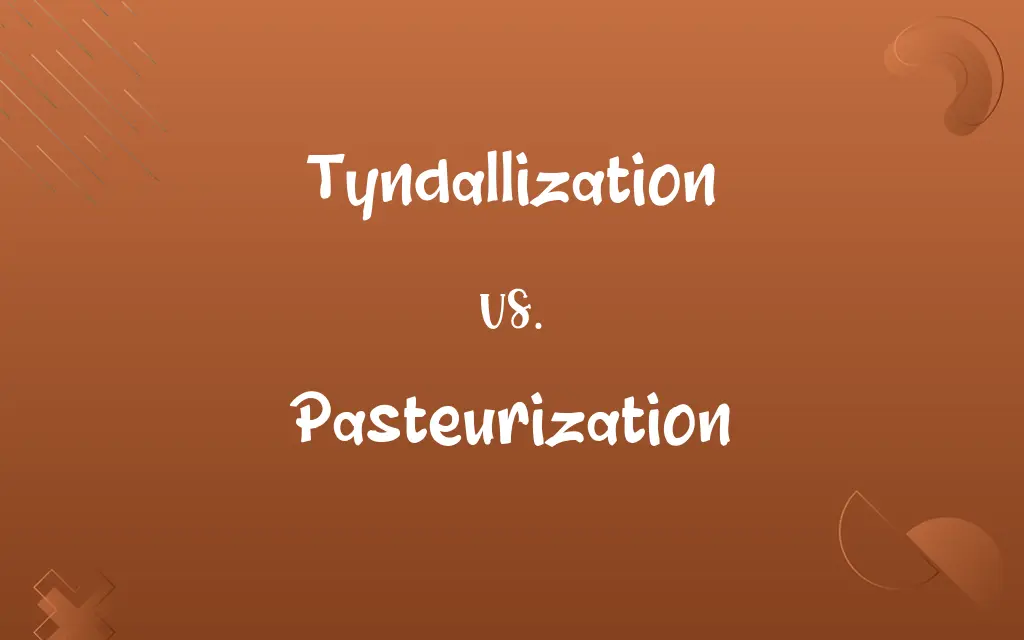Tyndallization vs. Pasteurization: Know the Difference

By Shumaila Saeed || Published on January 5, 2024
Tyndallization is a sterilization method involving intermittent heating, while pasteurization is a process of heating food to kill harmful microorganisms.

Key Differences
Tyndallization involves heating substances intermittently over three days to sterilize them, targeting heat-resistant spores. Pasteurization involves heating a substance (usually liquid) to a specific temperature for a set period to eliminate pathogens.
Shumaila Saeed
Jan 05, 2024
In Tyndallization, the substance is heated to boiling temperatures intermittently over a few days. Pasteurization typically heats substances to temperatures below boiling (around 60-85°C) for shorter periods, like 15-30 minutes.
Shumaila Saeed
Jan 05, 2024
Tyndallization aims at complete sterilization, including destruction of heat-resistant bacterial spores. Pasteurization's goal is to reduce microbial load to safe levels, not necessarily achieving complete sterilization.
Shumaila Saeed
Jan 05, 2024
Tyndallization is more common in laboratory settings for sterilizing nutrient media. Pasteurization is widely used in the food industry, especially for milk and dairy products, to prolong shelf life and ensure safety.
Shumaila Saeed
Jan 05, 2024
Tyndallization was developed by John Tyndall in the 19th century as a method to achieve sterility in lab environments. Pasteurization, developed by Louis Pasteur, was initially used to prevent wine and beer spoilage and later adapted for milk.
Shumaila Saeed
Jan 05, 2024
ADVERTISEMENT
Comparison Chart
Process
Intermittent heating over several days
Heating to a specific temperature for a short duration
Shumaila Saeed
Jan 05, 2024
Purpose
Complete sterilization, including spores
Reducing microbial load to safe levels
Shumaila Saeed
Jan 05, 2024
Typical Applications
Sterilizing nutrient media in labs
Widely used in food industry for milk, juices, etc.
Shumaila Saeed
Jan 05, 2024
Historical Development
Developed by John Tyndall in the 19th century
Developed by Louis Pasteur for wine, beer, and milk
Shumaila Saeed
Jan 05, 2024
ADVERTISEMENT
Tyndallization and Pasteurization Definitions
Tyndallization
A method of sterilization by intermittent heating.
Tyndallization was used to ensure the nutrient broth remained sterile over the course of the experiment.
Shumaila Saeed
Dec 28, 2023
Pasteurization
A technique to reduce microbial load in food and beverages.
Pasteurization is essential in the dairy industry to ensure safety.
Shumaila Saeed
Dec 28, 2023
Tyndallization
Sterilization technique targeting heat-resistant spores.
Tyndallization effectively eliminated the spores that survived the initial boiling.
Shumaila Saeed
Dec 28, 2023
Pasteurization
A method developed by Louis Pasteur to prevent food spoilage.
Pasteurization was originally developed to prevent wine spoilage.
Shumaila Saeed
Dec 28, 2023
Tyndallization
A process involving repeated boiling and cooling over several days.
To prepare the media for sensitive experiments, they employed tyndallization.
Shumaila Saeed
Dec 28, 2023
ADVERTISEMENT
Pasteurization
A process of heating food to kill harmful microorganisms.
Pasteurization of milk helps in eliminating pathogenic bacteria.
Shumaila Saeed
Dec 28, 2023
Tyndallization
Intermittent sterilization process named after John Tyndall.
Tyndallization was a crucial process before the advent of autoclaves.
Shumaila Saeed
Dec 28, 2023
Pasteurization
Heating a substance to a specific temperature for a set period.
The pasteurization of juice extends its shelf life.
Shumaila Saeed
Dec 28, 2023
Tyndallization
A method for achieving sterility in laboratory environments.
The microbiology lab used tyndallization for preparing culture media.
Shumaila Saeed
Dec 28, 2023
Pasteurization
Heating process aimed at prolonging shelf life and safety.
Pasteurization of dairy products is a standard industry practice.
Shumaila Saeed
Dec 28, 2023
Pasteurization
The act or process of heating a food, especially a beverage such as milk or beer, to a specific temperature for a specific period of time in order to kill microorganisms that could cause disease, spoilage, or undesired fermentation.
Shumaila Saeed
Dec 27, 2023
Pasteurization
The act or process of destroying most microorganisms in certain foods, such as raw meat or fresh fruits and vegetables, by irradiating them with gamma rays or other radiation to prevent spoilage.
Shumaila Saeed
Dec 27, 2023
Pasteurization
A process devised by Pasteur for preventing or checking fermentation in fluids, such as wines, milk, etc., by exposure to a temperature of 140° F., thus destroying the vitality of the contained microorganisms.
Shumaila Saeed
Dec 27, 2023
Pasteurization
Partial sterilization of foods at a temperature that destroys harmful microorganisms without major changes in the chemistry of the food
Shumaila Saeed
Dec 27, 2023
Repeatedly Asked Queries
Why is Tyndallization not commonly used today?
Tyndallization is less efficient and more time-consuming compared to modern sterilization methods like autoclaving.
Shumaila Saeed
Jan 05, 2024
What does pasteurization entail?
Pasteurization involves heating food or liquid to kill harmful microorganisms.
Shumaila Saeed
Jan 05, 2024
Can Tyndallization be used for food preservation?
Tyndallization is generally not used for food preservation due to its lengthy process.
Shumaila Saeed
Jan 05, 2024
How does pasteurization affect the nutritional value of food?
Pasteurization may slightly alter some nutritional components but generally retains most of the food's nutritional value.
Shumaila Saeed
Jan 05, 2024
What is Tyndallization?
Tyndallization is a sterilization method involving repeated heating and cooling.
Shumaila Saeed
Jan 05, 2024
Is Tyndallization used in medical settings?
Tyndallization is rarely used in modern medical settings due to better alternatives.
Shumaila Saeed
Jan 05, 2024
Is pasteurization effective against all microorganisms?
Pasteurization significantly reduces harmful microorganisms but may not eliminate all.
Shumaila Saeed
Jan 05, 2024
Can Tyndallization kill all types of bacteria?
Tyndallization is effective against most bacteria, including heat-resistant spores.
Shumaila Saeed
Jan 05, 2024
What are the main advantages of pasteurization?
The main advantages are improved food safety and extended shelf life.
Shumaila Saeed
Jan 05, 2024
Is Tyndallization more effective than boiling?
Tyndallization is more effective than a single boiling session, especially against heat-resistant spores.
Shumaila Saeed
Jan 05, 2024
Is Tyndallization safe for all types of media in labs?
While safe for many types, some sensitive materials may not be suitable for tyndallization.
Shumaila Saeed
Jan 05, 2024
What is the difference in energy consumption between the two processes?
Pasteurization is generally more energy-efficient compared to tyndallization.
Shumaila Saeed
Jan 05, 2024
How long does Tyndallization take?
Tyndallization typically takes three days to complete.
Shumaila Saeed
Jan 05, 2024
Does pasteurization require special equipment?
Pasteurization requires controlled heating equipment but is generally straightforward.
Shumaila Saeed
Jan 05, 2024
What foods are commonly pasteurized?
Common pasteurized foods include milk, cheese, juices, and eggs.
Shumaila Saeed
Jan 05, 2024
Can Tyndallization be used at home?
It's impractical for home use due to its complexity and time requirements.
Shumaila Saeed
Jan 05, 2024
What temperatures are used in pasteurization?
Pasteurization typically uses temperatures below boiling, around 60-85°C.
Shumaila Saeed
Jan 05, 2024
What is the primary purpose of Tyndallization in labs?
Its primary purpose is to sterilize nutrient media and other lab materials.
Shumaila Saeed
Jan 05, 2024
How does pasteurization impact the taste of food?
Pasteurization can slightly change the taste, but these changes are usually minimal.
Shumaila Saeed
Jan 05, 2024
Why was pasteurization initially developed?
It was developed by Louis Pasteur to prevent spoilage in wine and beer.
Shumaila Saeed
Jan 05, 2024
Share this page
Link for your blog / website
HTML
Link to share via messenger
About Author
Written by
Shumaila SaeedShumaila Saeed, an expert content creator with 6 years of experience, specializes in distilling complex topics into easily digestible comparisons, shining a light on the nuances that both inform and educate readers with clarity and accuracy.








































































